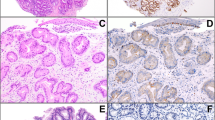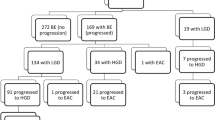Abstract
The incidence of adenocarcinoma of the esophagus and gastroesophageal junction has increased dramatically over the past 30 years. The major precursor to this type of adenocarcinoma is Barrett esophagus, which is defined as the conversion of normal squamous epithelium into metaplastic columnar epithelium. Abundant evidence suggests that adenocarcinoma in the setting of Barrett esophagus develops via a progressive sequence of histological and molecular events. Consequently, patients with Barrett esophagus routinely undergo endoscopic surveillance for early detection of neoplasia. Histological evaluation of mucosal biopsy samples from the esophagus and gastroesophageal junction for identification of goblet cells and evaluation of the presence, grade and extent of dysplasia is the mainstay of risk assessment for these patients. This Review provides physicians with a summary of the pertinent, clinically relevant histological features of Barrett esophagus and its neoplastic complications. The histology of Barrett esophagus and the gastroesophageal junction is summarized, and an overview of information necessary to interpret pathology reports from patients either with or without endoscopic evidence of Barrett esophagus is provided to appropriately guide management of patients. Close interaction between the clinician and the pathologist is essential for proper interpretation of biopsy results and to provide optimal surveillance or treatment strategies.
Key Points
-
The presence of goblet cells depends on a variety of factors, including patients' age, length of Barrett esophagus, presence of neoplasia, and location from which biopsy samples were obtained
-
Mesenchymal changes, such as duplication of the muscularis mucosa in addition to columnar metaplasia, are common and make interpretation of depth-of-invasion of adenocarcinoma difficult in mucosal biopsy specimens
-
Emerging evidence suggests that the background nongoblet columnar epithelium in patients with Barrett esophagus demonstrates intestinal differentiation and molecular abnormalities, which suggests it is at risk of neoplastic change
-
Interobserver variability in diagnosis of dysplasia in Barrett esophagus is high; all biopsy samples identified as indefinite or positive for dysplasia should, therefore, be reviewed by an expert gastrointestinal pathologist
-
The incidence, natural history, and risk of malignancy for patients with extremely short segments of esophageal columnar metaplasia is unknown and requires further study
-
Evaluation and treatment of patients with dysplasia should take into consideration the number of pathologists who have agreed with the diagnosis, as well as the endoscopic appearance and location of the lesion
This is a preview of subscription content, access via your institution
Access options
Subscribe to this journal
Receive 12 print issues and online access
$209.00 per year
only $17.42 per issue
Buy this article
- Purchase on Springer Link
- Instant access to full article PDF
Prices may be subject to local taxes which are calculated during checkout








Similar content being viewed by others
References
Pohl, H. & Welch, H. G. The role of overdiagnosis and reclassification in the marked increase of esophageal adenocarcinoma incidence. J. Natl Cancer Inst. 97, 142–146 (2005).
Wang, K. K. & Sampliner, R. E. Practice Parameters Committee of the American College of Gastroenterology. Updated guidelines 2008 for the diagnosis, surveillance and therapy of Barrett's esophagus. Am. J. Gastroenterol. 103, 788–797 (2008).
Haggit, R. C. Barrett's esophagus, dysplasia, and adenocarcinoma. Hum. Pathol. 25, 982–993 (1994).
Spechler, S. J. Barrett's esophagus and esophageal adenocarcinoma: pathogenesis, diagnosis, and therapy. Med. Clin. North Am. 86, 1423–1445 (2002).
Odze, R. D. Update on the diagnosis and treatment of Barrett's esophagus and related neoplastic precursor lesions. Arch. Pathol. Lab. Med. 132, 1577–1585 (2008).
Odze, R. D. Pathology of the gastroesophageal junction. Semin. Diag. Pathol. 22, 256–265 (2005).
Glickman, J. N. et al. Phenotypic characteristics of a distinctive multilayered eptihelium suggests that it is a precursor in the development of Barrett's esophagus. Am. J. Surg. Pathol. 25, 569–578 (2001).
Glickman, J. N. et al. Multilayered epithelium in mucosal biopsy specimens from the gastroesophageal junction region is a histologic marker of gastroesophageal reflux disease. Am. J. Surg. Pathol. doi:10.1097/PAS.0b013e3181984697.
Shields, H. et al. Prospective evaluation of multilayered epithelium in Barrett's esophagus. Am. J. Gastroenterol. 96, 3267–3273 (2001).
Mino-Kenudson, M., Srivastava, A., Glickman, J. N. & Odze, R. D. Esophageal multilayered epithelium is a dynamic epithelium with bidirectional (squamous and columnar) differentiation capability [Abstract]. Gastroenterology (in press).
Gatenby, P., Ramus, J. & Caygill, C. Relevance of the detection of intestinal metaplasia in non-dysplastic columnar-line oesophagus. Scand. J. Gastroenterol. 43, 524–530 (2008).
Harrison, R. et al. Detection of intestinal metaplasia in Barrett's esophagus: an observational comparator study suggests the need for a minimum of eight biopsies. Am. J. Gastroenterol. 102, 1154–1161 (2007).
Dahms, B. B. & Rothstein, F. C. Barrett's esophagus in children: a consequence of chronic gastroesophageal reflux. Gastroenterology 86, 318–323 (1984).
Chandrasoma, P., Der, R. & Dalton, P. Distribution and significance of epithelial types in columnar-lined esophagus. Am. J. Surg. Pathol. 25, 1188–1193 (2001).
Odze, R. D. Diagnosis and grading of dysplasia in Barrett's oesophagus. J. Clin. Pathol. 59, 1029–1038 (2006).
Srivastava, A. et al. Morphological features are useful in distinguishing Barrett's esophagus from carditis with intestinal metaplasia. Am. J. Surg. Pathol. 31, 1733–1741 (2007).
Hahn, H., Shahsafaei, A. & Odze, R. D. Vascular and lymphatic properties of the superficial and deep lamina propria in Barrett's esophagus. Am. J. Surg. Pathol. 32, 1454–1461 (2008).
Lewis, J. T., Wang, K. K. & Abraham, S. C. Muscularis mucosae duplication and the musculo-fibrous anomaly in endoscopic mucosal resections for Barrett's esophagus: implications for staging of adenocarcinoma. Am. J. Surg. Pathol. 32, 566–571 (2008).
Mino-Kenudson, M. et al. Endoscopic mucosal resection for Barrett's esophagus related superficial neoplasms offer better diagnostic concordance between pathologists than biopsy specimens. Gastrointest. Endosc. 66, 660–666 (2007).
Offner, F. A., Lewin, K. J. & Weinstein, W. M. Metaplastic columnar cells in Barrett's esophagus: a common and neglected cell type. Hum. Pathol. 27, 885–889 (1996).
Chen, Y. Y. et al. Significance of acid-mucin-positive nongoblet columnar cells in the distal esophagus and gastroesophageal junction. Hum. Pathol. 30, 1488–1495 (1999).
Sharma, P. et al. The development and validation of an endoscopic grading system for Barrett's esophagus: the Prague C & M criteria. Gastroenterology 131, 1392–1399 (2006).
Sharma, P., Morales, T. G. & Sampliner, R. E. Short segment Barrett's esophagus: the need for standardization of the definition and of endoscopic criteria. Am. J. Gastroenterol. 93, 1033–1036 (1998).
Derdoy, J. J. et al. The gastric cardia. To be or not to be? Am. J. Surg. Pathol. 27, 499–504 (2003).
Reid, B. J. et al. Observer variation in the diagnosis of dysplasia in Barrett's esophagus. Hum. Pathol. 19, 166–178 (1988).
Schlemper, R. J. et al. The Vienna classification of gastroentestinal epithelial neoplasia. Gut 47, 251–255 (2000).
Lomo, L. et al. Crypt dysplasia with surface maturation: a clinical, pathologic and molecular study of Barrett's esophagus cohort. Am. J. Surg. Pathol. 30, 423–435 (2006).
Zhang, X. et al. DNA ploidy abnormalities in basal and superficial regions of the crypts in Barrett's esophagus and associated neoplastic lesions. Am. J. Surg. Pathol. 32, 1327–1335 (2008).
Montgomery, E. et al. Reproducibility of the diagnosis of dysplasia in Barrett's esophagus: a reaffirmation. Hum. Pathol. 32, 368–378 (2001).
Haggitt, R. C. et al. Adenocarcinoma complicating columnar epithelium lined (Barrett's) esophagus. Am. J. Clin. Pathol. 70, 1–5 (1978).
Paraf, F. et al. Surgical pathology of adenocarcinoma arising in Barrett's esophagus. Am. J. Surg. Pathol. 19, 183–191 (1995).
Skinner, D. B. et al. Barrett's esophagus: comparison of benign and malignant cases. Ann. Surg. 198, 544–566 (1983).
Smith, R. R. L. et al. The spectrum of carcinoma arising in Barrett's esophagus. Am. J. Surg. Pathol. 8, 563–573 (1984).
Takubo, K. et al. Cardiac rather than intestinal-type background in endoscopic resection specimens of minute Barrett adenocarcinoma. Hum. Pathol. 40, 65–74 (2009).
Srivastava, A. et al. Loss of goblet cell differentiation occurs with the progression of dysplasia in Barrett's esophagus [Abstract]. Gastroenterology 130, A264 (2006).
Chandrasoma, P. et al. Histologic classification of patients based on mapping biopsies of the gastroesophageal junction. Am. J. Surg. Pathol. 27, 929–936 (2003).
Goldstein, N. Gastric cardia intestinal metaplasia: biopsy follow-up of 85 patients. Mod. Pathol. 13, 1072–1079 (2000).
Paull, A. et al. The histologic spectrum of Barrett's esophagus. N. Engl. J. Med. 295, 476–480 (1976).
Thompson, J. J., Zinsser, K. & Enterline, H. Barrett's metaplasia and adenocarcinoma of the esophagus and gastroesophageal junction. Hum. Pathol. 14, 42–61 (1983).
Oberg, S. et al. Endoscopic surveillance of columnar-lined esophagus: frequency of intestinal metaplasia detection and impact of antireflux surgery. Ann. Surg. 234, 619–626 (2001).
Horwhat, J. D. et al. A randomized comparison of methylene blue-directed biopsy versus conventional four-quadrant biopsy for the detection of intestinal metaplasia and dysplasia in patients with long-segment Barrett's esophagus. Am. J. Gastroenterol. 103, 546–554 (2008).
Wong, R. K., Horwhat, J. D. & Maydonovitch, C. L. Sky blue or murky waters: the diagnostic utility of methylene blue. Gastrointest. Endosc. 54, 409–413 (2001).
Breyer, H. P. et al. Does methylene blue detect intestinal metaplasia in Barrett's esophagus? Gastrointest. Endosc. 57, 505–509 (2003).
Wo, J. M. et al. Comparison of methylene blue-directed biopsies and conventional biopsies in the detection of intestinal metaplasia and dysplasia in Barrett's esophagus: a preliminary study. Gastrointest. Endosc. 54, 294–301 (2001).
Gossner, L. et al. Comparison of methylene blue-directed biopsies and four-quadrant biopsies in the detection of high-grade intraepithelial neoplasia and early cancer in Barrett's oesophagus. Dig. Liver Dis. 38, 724–729 (2006).
Jobson, B. et al. Methylene blue staining for intestinal metaplasia in Barrett's esophagus—is it as good as we think? [Abstract]. Gastrointest. Endosc. 49, AB52 (1999).
Kara, M. A. et al. Endoscopic video-autofluorescence imaging followed by narrow band imaging for detecting early neoplasia in Barrett's esophagus. Gastrointest. Endosc. 64, 176–185 (2006).
Kara, M. A. et al. Detection and classification of the mucosal and vascular patterns (mucosal morphology) in Barrett's esophagus by using narrow band imaging. Gastrointest. Endosc. 64, 155–166 (2006).
Theisen, J. et al. Preferred location for the development of esophageal adenocarcinoma within a segment of intestinal metaplasia. Surg. Endosc. 20, 235–238 (2006).
Buttar, N. S. et al. Extent of high-grade dysplasia in Barrett's esophagus correlates with risk of adenocarcinoma. Gastroenterology 120, 1630–1639 (2001).
Montgomery, E. et al. Are ulcers a marker for invasive carcinoma in Barrett's esophagus? Data from a diagnostic variability study with clinical follow-up. Am. J. Gastroenterol. 97, 27–31 (2002).
Reid, B. J. et al. Endoscopic biopsy can detect high-grade dysplasia or early adenocarcinoma in Barrett's esophagus without grossly recognizable neoplastic lesions. Gastroenterology 94, 81–90 (1988).
Reid, B. J. et al. Optimizing endoscopic biopsy detection of early cancers in Barrett's high-grade dysplasia. Am. J. Gastroenterol. 95, 3089–3096 (2000).
Abela, J. E. et al. Systematic four-quadrant biopsy detects Barrett's dysplasia in more patients than nonsystematic biopsy. Am. J. Gastroenterol. 103, 850–855 (2008).
Anagnostopoulos, G. K. et al. Novel endoscopic observation in Barrett's oesophagus using high resolution magnification endoscopy and narrow band imaging. Aliment Pharmacol. Ther. 26, 501–507 (2007).
Sharma, P. et al. Non-biopsy detection of intestinal metaplasia and dysplasia in Barrett's esophagus: a prospective multicenter study. Endoscopy 38, 1206–1212 (2006).
Lim, C. H. et al. Randomized crossover study that used methylene blue or random 4-quadrant biopsy for the diagnosis of dysplasia in Barrett's esophagus. Gastrointest. Endosc. 64, 195–199 (2006).
Kelty, C. Barrett's oesophagus: intestinal metaplasia is not essential for cancer risk. Scand. J. Gastroenterol. 102, 1154–1161 (2007).
Hahn, H. P. et al. Intestinal differentiation in metaplastic, non-goblet columnar epithelium in the esophagus. Am. J. Surg. Pathol. doi:10.1097/PAS.0b013e31819f57e9.
Liu, W. et al. Metaplastic esophageal columnar epithelium without goblet cells shows DNA content abnormalities similar to goblet cell containing epithelium. Am. J. Gastroenterol. 104, 816–824 (2009).
Chaves, P. et al. Chromosomal analysis of Barrett's cells: demonstration of instability and detection of the metaplastic lineage involved. Mod. Pathol. 20, 788–796 (2007).
Romagnoli, S. et al. Molecular alterations of Barrett's esophagus on microdissected endoscopic biopsies. Lab. Invest. 81, 241–247 (2001).
Odze, R. D. Unraveling the mystery of the gastroesophageal junction: a pathologist's perspective. Am. J. Gastroenterol. 100, 1853–1867 (2005).
Spechler, S. J. Intestinal metaplasia at the gastroesophageal junction. Gastroenterology 126, 567–575 (2004).
Goldblum, J. R. et al. Inflammation and intestinal metaplasia of the gastric cardia: the role of gastroesophageal reflux and H. pylori infection. Gastroenterology 114, 633–639 (1998).
Spechler, S. J. et al. GERD versus, H. pylori infections as potential causes of inflammation in the gastric cardia [Abstract]. Gastroenterology 112, A297 (1997).
Hackelsberger, A. et al. Intestinal metaplasia at the gastro-oesophageal junction, Helicobacter pylori gastritis or gastro-oesophageal reflux disease? Gut 43, 17–21 (1998).
Morales, T. G. et al. Is Barrett's esophagus associated with intestinal metaplasia of the gastric cardia? Am. J. Gastroenterol. 92, 1818–1822 (1997).
Pera, M. Trends in incidence and prevalence of specialized intestinal metaplasia, Barrett's esophagus, and adenocarcinoma of the gastroesophageal junction. World J. Surg. 27, 999–1008 (2003).
Ruol, A. et al. Intestinal metaplasia is the probable common precursor of adenocarcinoma in Barrett's esophagus and adenocarcinoma of the gastric cardia. Cancer 88, 2520–2528 (2000).
Cameron, A. J., Souto, E. O. & Smyrk, T. C. Small adenocarcinomas of the esophagogastric junction: association with intestinal metaplasia and dysplasia. Am. J. Gastroenterol. 97, 1375–1380 (2002).
Sharma, P. et al. Dysplasia in short-segment Barrett's esophagus: a prospective 3-year follow-up. Am. J. Gastroenterol. 92, 2012–2016 (1997).
Sharma, P. et al. Relative risk of dysplasia for patients with intestinal metaplasia in the distal oesophagus and in the gastric cardia. Gut 46, 9–13 (2000).
Chu, P. G., Jiang, Z. & Weiss, L. M. Hepatocyte antigen as a marker of intestinal metaplasia. Am. J. Surg. Pathol. 27, 952–959 (2003).
Sarbia, M. et al. Distinction between intestinal metaplasia in the cardia and in Barrett's esophagus: the role of histology and immunohistochemistry. Hum. Pathol. 35, 371–376 (2004).
Freund, J. N. et al. Cdx1 and Cdx2 homeobox genes in the intestine. Biochem. Cell Biol. 76, 957–969 (1998).
Chu, P. G. et al. Hepatocyte antigen as a marker of hepatocellular carcinoma: an immunohistochemical comparison to, C.E.A., CD10, and AFP. Am. J. Surg. Pathol. 26, 978–988 (2002).
Ornsby, A. H. et al. Cytokeratins subsets can reliably distinguish Barrett's esophagus from intestinal metaplasia of the stomach. Hum. Pathol. 30, 288–294 (1999).
Glickman, J. N. et al. Phenotype of Barrett's esophagus and intestinal metaplasia of the distal esophagus and gastroesophageal junction. An immunohistochemical study of cytokeratins 7 and 20, DAS-1, and 45MI. Am. J. Surg. Pathol. 25, 87–94 (2001).
Odze, R. D. Cytokeratin 7/20 immunostaining: Barrett's oesophagus or gastric intestinal metaplasia? Lancet 359, 1711–1713 (2002).
Kerkhof, M. et al. Grading of dysplasia in Barrett's oesophagus: substantial interobserver variation between general and gastrointestinal pathologists. Histopathology 50, 920–927 (2007).
Hornick, J. L. & Odze, R. D. Neoplastic precursor lesions in Barrett's esophagus. Gastroenterol. Clin. N. Am. 36, 775–796 (2007).
Feith, M. et al. Malignant degeneration of Barrett's esophagus: the role of the Ki-67 proliferation fraction, expression of E-cadherin and p53. Dis. Esophagus 17, 322–327 (2004).
Bani-Hani, K. et al. Prospective study of cyclin D1 overexpression in Barrett's esophagus: association with increased risk of adenocarcinoma. J. Natl Cancer Inst. 92, 1316–1321 (2000).
Hong, M. K. et al. Expansion of the Ki-67 proliferative compartment correlates with degree of dysplasia in Barrett's esophagus. Cancer 75, 423–429 (1995).
Reid, B. J. P53 and neoplastic progression in Barrett's esophagus. Am. J. Gastroenterol. 96, 1321–1323 (2001).
Younes, M. et al. P53 protein accumulation in Barrett's metaplasia, dysplasia, and carcinoma: a follow-up study. Gastroenterology 105, 1637–1642 (1993).
Dorer, R. & Odze, R. D. AMACR immunostaining is useful in detecting dysplastic epithelium in Barrett's esophagus, ulcerative colitis, and Crohn's disease. Am. J. Surg. Pathol. 30, 871–877 (2006).
Lisovsky, M., Falkowski, O. & Bhuiya, T. Expression of alpha-methylacyl-coenzyme A racemase in dysplastic Barrett's epithelium. Hum. Pathol. 37, 1601–1606 (2006).
Scheil-Bertram, S. et al. Expression of α-methylacyl coenzyme A racemase in the dysplasia carcinoma sequence associated with Barrett's esophagus. Mod. Pathol. 21, 961–967 (2008).
Thurberg, B. L., Duray, P. H. & Odze, R. D. Polypoid dysplasia in Barrett's esophagus: a clinicopathologic, immunohistochemical, and molecular study of five cases. Hum. Pathol. 30, 745–752 (1999).
Hillman, L. C. et al. Acid peptic disease and complication: Barrett's esophagus: macroscopic markers and the prediction of dysplasia and adenocarcinoma. J. Gastroenterol. Hepatol. 18, 526–533 (2003).
Reid, B. J. et al. Predictors of progression to cancer in Barrett's esophagus: baseline histology and flow cytometry identify low- and high-risk patient subsets. Am. J. Gastroenterol. 95, 1669–1676 (2000).
Weston, A. P. et al. P53 protein overexpression in low-grade dysplasia (LG) in Barrett's esophagus: immunohistochemical marker predictive of progression. Am. J. Gastroenterol. 96, 1355–1362 (2001).
Skacel, M. et al. The diagnosis of low-grade dysplasia in Barrett's esophagus and its implications for disease progression. Am. J. Gastroenterol. 95, 3383–3387 (2000).
Srivastava, A. et al. Extent of low-grade dysplasia is a risk factor for the development of esophageal adenocarcinoma in Barrett's esophagus. Am. J. Gastroenterol. 102, 483–493 (2007).
Schnell, T. G. et al. Long-term nonsurgical management of Barrett's esophagus with high-grade dysplasia. Gastroenterology 120, 1607–1619 (2001).
Weston, A. P. et al. Long-term follow-up of Barrett's high-grade dysplasia. Am. J. Gastroenterol. 95, 1888–1893 (2000).
Dar, M. S. et al. Can. extent of high-grade dysplasia in Barrett's oesophagus predict the presence of adenocarcinoma at oesophagectomy? Gut 52, 486–489 (2003).
Acknowledgements
Charles P. Vega, University of California, Irvine, CA, is the author of and is solely responsible for the content of the learning objectives, questions and answers of the MedscapeCME-accredited continuing medical education activity associated with this article.
Author information
Authors and Affiliations
Corresponding author
Ethics declarations
Competing interests
The author declares no competing financial interests.
Rights and permissions
About this article
Cite this article
Odze, R. Barrett esophagus: histology and pathology for the clinician. Nat Rev Gastroenterol Hepatol 6, 478–490 (2009). https://doi.org/10.1038/nrgastro.2009.103
Published:
Issue Date:
DOI: https://doi.org/10.1038/nrgastro.2009.103
This article is cited by
-
Predictive value of p53, Ki67 and TLR5 in neoplastic progression of Barrett’s esophagus: a matched case–control study
Virchows Archiv (2022)
-
Toll-like receptor 9 expression in the natural history of Barrett mucosa
Virchows Archiv (2015)
-
Increased Toll-like receptor 5 expression indicates esophageal columnar dysplasia
Virchows Archiv (2014)
-
MicroRNA Expression Profiling in the Histological Subtypes of Barrett's Metaplasia
Clinical and Translational Gastroenterology (2013)
-
Gastroesophageal reflux disease—from reflux episodes to mucosal inflammation
Nature Reviews Gastroenterology & Hepatology (2012)



